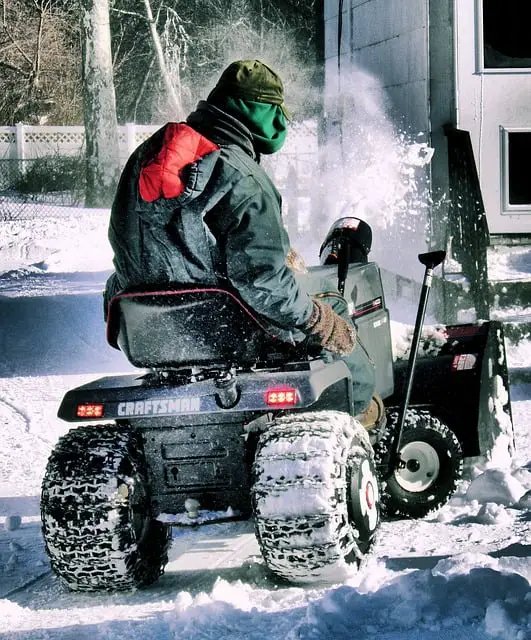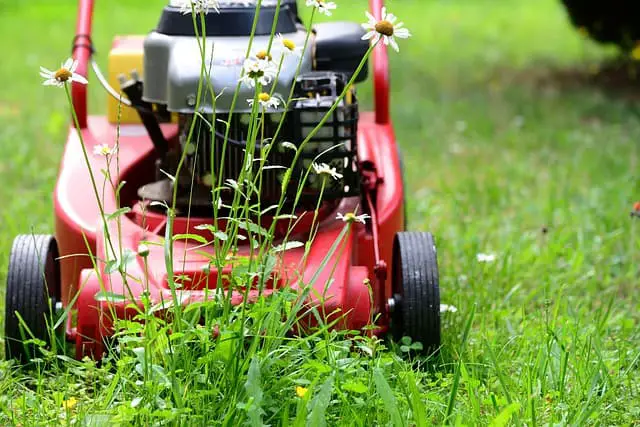The easiest and most efficient way to keep snow from sticking to your snowblower is to use a good spray lubricant. You can successfully use PAM spray, snow and ice repellant sprays, or exterior care teflon sprays for cars.
Another way to prevent snow from sticking is to simply walk faster when using your snowblower, and to clear out the snow as early in the day as possible.
Frequently removing small amounts of snow also helps prevent snow from sticking to your snowblower is a third option.
If you were unable to ward off the snow from sticking and ended up with a clogged snowblower, then don’t worry; in this article, we’ll discuss how to unclog the chute as well.
Why Does Snow Stick Anyway?
Heavy, partially-melted wet snow that has a high moisture content is more likely to stick together into clumps than light, soft snow. This tendency to clump together means that it will be more difficult for the snow to move through the snowblower augur and chute, hence increasing the likelihood of snow clumps sticking inside the snowblower.
Walking too slow also causes snow to stick. You might think operating your snowblower slowly will give a clearer surface, but in actuality it’s allowing the snow more time to clump together. This of course raises the chances of clogging.
What Kind of Lubricant Spray Should Be Used?
Nonstick sprays are considered the best lubricants for this job. Just like any cooking spray, it coats the auger and chute and keeps them slippery, so the snow can easily pass without sticking or clumping.
These sprays have additional benefits as well, such as offering UV protection and rust prevention, which help improve the longevity of your snowblower. Some sprays even add a glossy finish. They also prevent dirt and grass from clogging.
Can I Use Any Other Lubricants Instead?
You should be able to find a good snowblower nonstick spray at your nearest hardware store, but in case you unable to find one, using cooking spray or WD-40 instead is alright. Avoid vegetable oil and grease, as they don’t last long and make the entire procedure messy.
How Often Would I Have to Use a Nonstick Spray?
Most specialized nonstick sprays are made to last at least 4 weeks. One-time use sprays have to be reapplied before each use, which can be extremely inconvenient if you are in a rush and need the driveway cleared as quick as possible.
Try to purchase a spray which will keep your snowblower lubricated for a long time.
To make the most of your nonstick spray, apply more than one layer of coating.
Are There Any Precautions I Should Take with the Nonstick Spray?
Like with any other product, be sure to thoroughly read the manufacturer’s instructions on how to use the nonstick spray. Keep it away from kids and pets as it contains hazardous ingredients.
Use the spray in a well-ventilated space, use adequate eye and mouth protection (goggles, masks, respirators etc.) and of course wear gloves when spraying.
Can I Use My Snowblower Immediately after Spraying?
No. Be mindful of the drying time, since the spray will not lubricate properly until it’s fully dried. For improved drying time, applying the spray in a warm and dry environment, like inside a garage. The warmth will help the spray dry quickly.
In extremely cold temperatures, most nonstick sprays can stick to wet surfaces, but they will take longer to dry. And remember that the spray might be flammable when drying, so keep it away from any flames.
What Does the Time of the Day Have to Do with Snow-blowing?
When the temperatures are lower, snow is light, dry and fluffy. Clearing out the snow with your snowblower early in the morning when the sun hasn’t melted the snow yet means you won’t have to deal with any heavy, wet snow than can stick to your snowblower.
Just How Fast Should I Walk When Operating My Snowblower?
As discussed in the beginning, walking too slow results in the snow sticking together into clumps. To avoid this, you should consider the size and power rating of your snowblower, and take on the appropriate amount of snow.
As a general rule of thumb, only clear half of the auger’s housing width with each push. This ensures that you’re not taking on too much snow at a time.
Why Should I Clear Less Snow More Frequently?
Not only is clearing 8 inches of snow twice easier than clearing 16 inches of snow, it also reduces the chances of snow sticking. It further helps maximize the effectiveness of your snowblower.
How Do I Know My Snowblower Has Been Clogged?
Your snowblower won’t throw snow that far if the chute has been clogged by snow.
My Snowblower Chute is Clogged. Can I Use My Hands to Unclog It?
Snow clogs the auger housing and chute of a snowblower, which causes the moving parts (augers and impellers) to come to an abrupt halt. While they remain stationary, they store up tension, and once the snowblower is unclogged they start moving immediately to release it.
And so, it goes without saying that you should never, ever use your hands (or feet) to unclog the snowblower chute. The U.S. Consumer Product Safety Commission (CPSC) recently reported 590 finger amputations from snowblowers in the previous year, and about 5,740 emergency room cases involving snowblowers.
Then How Do I Unclog It?
Simple, use an unclogging tool. Most snowblowers these days come with one. If you don’t have one, then using a stiff object like a broomstick or anything similar will work as well.
But before that, make sure your snowblower has been switched off. Wait for at least 2 minutes for the engine and moving parts to stop before you start unclogging. A lot of accidents can be prevented this way.
Using the tool, unclog the snow, remove the tool, and then attempt to snow-blow again to check if it’s clear. Once all the snow has been removed, apply your nonstick spray, and with that, you’re all set.
Meta-description: The snow season is approaching and you’re worried about snow sticking to your snowblower when you’re clearing out inches of snow? We’ve got just the solution for you! Click here to find out all about snowblower care and maintenance.
Hi, I’m John Stephens, chief editor and writer for Totalgardener.com. I’ve been gardening and raising animals for over 15 years starting with a small backyard plot in Northern Virginia where I grew corn, potatoes, squash, and using a high mulch technique called the Ruth Stout Method. I also raised ducks and small mammals for meat and eggs in a movable pen similar to the ones used by Joel Salatin. I later moved to Colorado where I experimented with growing greens using aquaponics inside. I eventually added a microgreens setup and home sprouting operation. I’m excited to share everything I’ve learned plus more from the other local gardening and animal raising experts I know.



